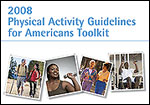|
|
|
|
|||||||||||
|
|
|||||||||||
|
|
Key Physical Activity Resources |
|
|||||||||
|
|
|||||||||||
|
|
|
||||||||||
|
|
|||||||||||
|
|
|||||||||||
Active Environments
 Interest in environmental and policy strategies to promote physical activity
has grown over the last few years and there is now a growing body of
evidence supporting such approaches. Environmental and policy approaches may
be especially important as they can benefit all people exposed to the
environment rather than focusing on changing physical activity behavior one
person at a time. Strategies often include providing access to facilities
and programs not currently available and supporting social environments that
favor activities. Examples include walking and bicycle trails, funding for
public facilities, zoning and land use that facilitates activity in
neighborhoods, mall walking programs, and building construction that
encourages physical activity. Such approaches hold particular promise for
promoting physical activity and should be taken into account in the design
of physical activity interventions. The links below provide public health,
community design and related sites that complement Active Community
Environments (ACES) efforts.
Interest in environmental and policy strategies to promote physical activity
has grown over the last few years and there is now a growing body of
evidence supporting such approaches. Environmental and policy approaches may
be especially important as they can benefit all people exposed to the
environment rather than focusing on changing physical activity behavior one
person at a time. Strategies often include providing access to facilities
and programs not currently available and supporting social environments that
favor activities. Examples include walking and bicycle trails, funding for
public facilities, zoning and land use that facilitates activity in
neighborhoods, mall walking programs, and building construction that
encourages physical activity. Such approaches hold particular promise for
promoting physical activity and should be taken into account in the design
of physical activity interventions. The links below provide public health,
community design and related sites that complement Active Community
Environments (ACES) efforts.
Active Community Environments Initiative
Encourages environmental and policy interventions that will affect increased
levels of physical activity and improved public health by promoting walking,
bicycling, and the development of accessible recreation facilities.
Designing &
Building Healthy Places
Promotes healthy community design. The interaction between people and their
environments, natural as well as human-made, continues to emerge as a major
issue concerning public health.
Environmental Change Strategies to Promote Physical Activity Quick Start![]() (PDF-74k)
(PDF-74k)
This resource provides key references, tools, and components for the
planning, implementation, evaluation, and maintenance of environmental
interventions to promote physical activity.
Promoting Physical Activity Through Trails
There is now scientific evidence that providing access to places for
physical activity increases the level of physical activity in a community.
Trails offer an opportunity for people to participate in physical activity
in a natural setting.
StairWELL to Better
Health
CDC study assesses whether making stairwells visually appealing with art and
signs motivate employees to use them, shows promising results.
Worksite
Walkability Audit Tool
A walkability audit tool is designed to broadly assess pedestrian
facilities, destinations, and surroundings along and near a walking route
and identify specific improvements that would make the route more attractive
and useful to pedestrians. Using CDC's Walkability Audit from this site can
help you assess the safety or attractiveness of the walking routes at your
worksite.
Related Resources

2008 Physical
Activity Guidelines Toolkit for Organizations and Communities |
The Robert Wood Johnson Foundation offers resources that can assist your community or project promote and change environments to support physical activity.
- Active Living by
Design*
Active Living by Design is a national program of The Robert Wood Johnson Foundation and is a part of the UNC School of Public Health in Chapel Hill, North Carolina. This program establishes and evaluates innovative approaches to increase physical activity through community design, public policies and communications strategies. -
Active Living Leadership*
Active Living Leadership is a National Initiative supported by the Robert Wood Johnson Foundation (RWJF), developed to support government leaders as they create and promote policies, programs and places that enable active living to improve the health, well-being and vitality of communities. -
Active
Living Resources*
This resource section provides an in depth review of important publications, presentations, tools and other information that support Active Living by Design.
Memorandum of Understanding (MOU) to Promote
Public Health and Recreation
Eleven federal programs joined forces, to promote uses and benefits of the
nation's public lands and water to promote uses and benefits of the
nation's public lands and water resources to enhance the physical and
psychological health and well being of the American people.
![]() Please note: Some of these publications are available for download only as *.pdf files. These files require Adobe Acrobat Reader in order to be viewed. Please review the information on downloading and using Acrobat Reader software.
Please note: Some of these publications are available for download only as *.pdf files. These files require Adobe Acrobat Reader in order to be viewed. Please review the information on downloading and using Acrobat Reader software.
* Links to non-Federal organizations found at this site are provided solely as a service to our users. These links do not constitute an endorsement of these organizations or their programs by CDC or the Federal Government, and none should be inferred. CDC is not responsible for the content of the individual organization Web pages found at these links.
Page last updated: October 7, 2008
Content Source: Division of Nutrition, Physical Activity and Obesity, National Center for Chronic Disease Prevention and Health Promotion
